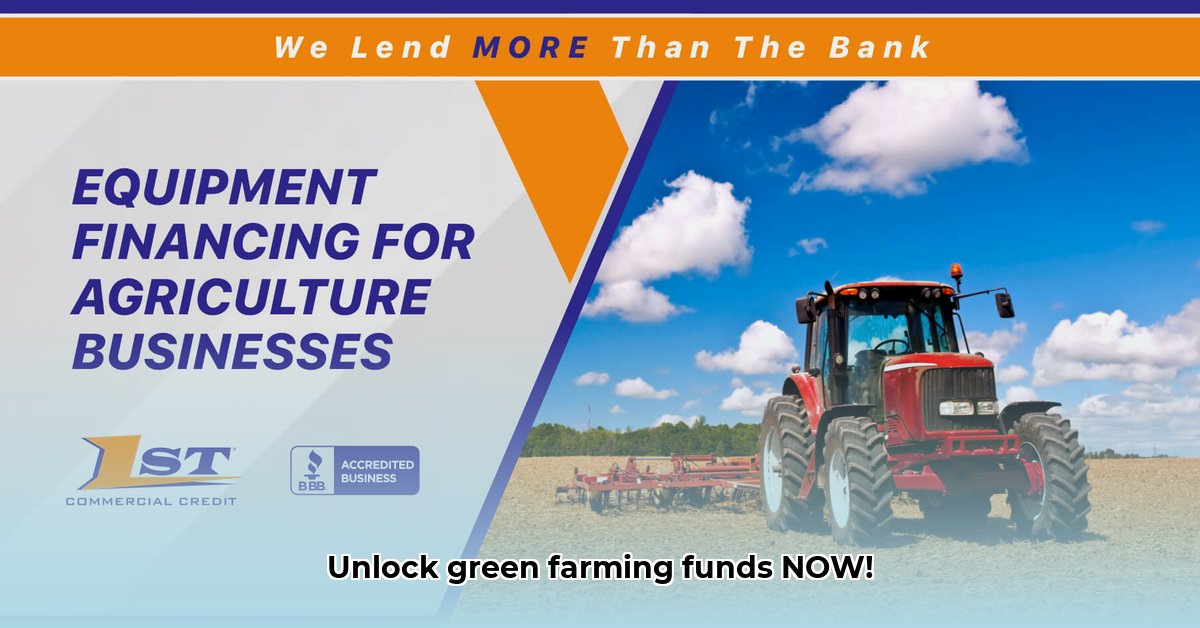
Understanding Sustainable Farm Equipment Financing
Securing funding for sustainable farm equipment is crucial for transitioning to environmentally friendly and economically viable farming practices. This guide will walk you through the various financing options available to help you acquire the equipment you need to build a greener, more profitable future. Don't let financing be a barrier to your farm's sustainability journey. Are you ready to learn how to secure the funds you need? For more on tractor financing, check out this helpful guide: Financing a Tractor.
Traditional Loans: Your Established Path
Traditional loans from banks and credit unions remain a common financing method for agricultural equipment. Interest rates, loan terms (the repayment period), and eligibility criteria vary significantly depending on the lender and your financial history. A strong credit score significantly improves your chances of approval and securing favorable interest rates. Remember to carefully analyze the total cost of the loan, including all interest payments over its lifespan.
Grants and Subsidies: Funding Your Green Transition
Numerous government programs at the federal, state, and local levels offer financial assistance to farmers adopting sustainable agricultural practices. These grants and subsidies can significantly reduce upfront costs. However, they often have specific requirements and competitive application processes. Thorough research into available programs is essential. Do you know which programs are available in your area?
Leasing: A Flexible Approach
Leasing offers a flexible alternative to outright purchase. Monthly payments are often lower than loan installments, making it a more manageable option. However, you won't own the equipment at the lease's end. Carefully consider this factor in relation to your long-term farm plans. Does leasing align with your long-term goals?
Alternative Financing: Exploring Untapped Potential
Crowdfunding platforms and impact investors offer alternative funding mechanisms, especially suitable for innovative sustainable farming projects. These options often resonate better with projects emphasizing environmental and social benefits. Are you prepared to showcase your farm’s commitment to sustainability?
Assessing Your Financing Needs: A Step-by-Step Plan
Before applying for financing, meticulously assess your funding needs. This crucial step ensures you request the right amount and avoid potential financial strain.
Equipment Costs: Obtain detailed quotes from multiple suppliers, including the cost of attachments and implements.
Operating Costs: Account for fuel, maintenance, insurance, and potential repairs. These recurring costs impact your overall budget.
Income Projections: Realistically project how the new equipment will enhance your farm's profitability. Will it lead to increased yields, reduced input costs, or expanded operations? Quantify these potential benefits. Will your increased output justify the investment?
Financing Gap: Determine the difference between your total estimated costs (steps 1-2) and the available funds. This gap represents your required financing.
Building a Strong Application: Presenting Your Case
Your loan application must paint a compelling picture of your farm's future, emphasizing both profitability and sustainability.
Comprehensive Business Plan: Present a well-structured business plan that outlines your market analysis, farm history, projected income and expenses, and clearly defined goals. Is your business plan a strong reflection of your farm's potential?
Sustainability Emphasis: Quantify the environmental benefits of your new equipment. For example, highlight fuel efficiency, water conservation, and carbon sequestration. Concrete data strengthens your application. Have you quantified the environmental impact of your upgrades?
Impeccable Financial Records: Provide neat, accurate financial records demonstrating responsible financial management. This builds lender confidence. Are your financial records meticulously maintained and readily available?
Environmental Impact Assessment: A concise assessment quantifying the positive environmental impact of your investment strengthens your application and showcases your commitment to sustainability.
Tips for Negotiating with Lenders: Securing the Best Deal
Effective communication is crucial when negotiating with lenders.
Highlight Long-Term Benefits: Emphasize increased efficiency, reduced environmental impact, and profitability.
Demonstrate Expertise: Showcase your understanding of the equipment and its benefits for your farm.
Negotiate Terms: Discuss loan terms, interest rates, and repayment schedules.
Present Alternative Plans: Show you've explored various financing options.
Finding Resources and Support: Navigating the Process
Numerous resources can assist you in securing financing.
Government Agencies: USDA, state departments of agriculture, local agricultural extension offices.
Non-profit Organizations: Environmental organizations, farm advocacy groups.
Financial Institutions: Banks, credit unions, specialized agricultural lenders.
Online Resources: Government websites, farm industry publications.
Securing financing for sustainable farm equipment is an investment in a healthier planet and a more profitable future. With careful planning and a proactive approach, you can build the sustainable farm of your dreams.